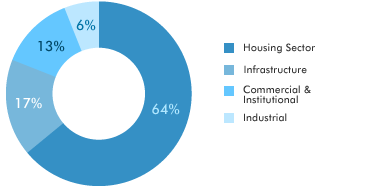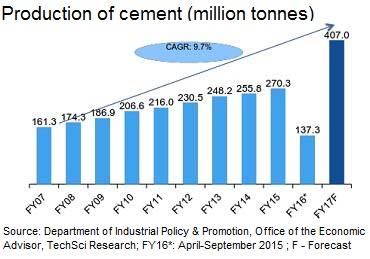-
Chapter 12: INDIAN INDUSTRIES
EVOLUTION OF INDUSTRIES
Industrial development is considered as one of the important indicators of socioeconomic and human development. Before the rise of modern industries, India was known all over the world for its cottage and household industries. Indian muslin, silk goods, and artistic pottery were in great demand the world over.
The arrival of English resulted in the decay of traditional handicrafts. The East India Company developed a policy of export of raw material from India to Britain and the import of finished products to India from Europe. It was because of this policy that no industry could be developed in India before 1854.
The industrial development in India started after 1854 when some cotton and jute mills were established by the British in Mumbai and Calcutta (Kolkata) respectively. The cotton textile industry expanded during 1870s when there was civil war in America.
After the First World War, the Indian industries got:a good boost as India became the main supplier of cotton and woollen textiles and liquors. The government gave protection to some of the industries.
The period during the Second World War was a time of crisis as India got involved into war. After the Second World War, the production fell down due to decreasing demand for industrial products, lack of capital, political unrest, transport bottlenecks, and labour strikes.
COTTON TEXTILE INDUSTRY
Textile industry includes cotton, jute, wool, silk, and synthetic fibre textiles. India is one the the leading producers of textile goods. It is one of the largest and most important sector in the economy in terms of output, foreign exchange earning, and employment in India
India enjoyed monopoly in the production of textile goods from 1500 BC to 1500 AD. Indian cotton and silk textiles were in great demand all over the world. It was the arrival of the British in India and the Industrial Revolution in Britain in 1779 which led to the downfall of the Indian manufacturing.
The industry suffered a setback in 1947 as good quality cotton growing area went to Pakistan. Consequently, India had to import cotton from the African countries.
Cotton being a pure raw material provides a chance to establish textile mill either in the areas of raw material or in the market. In India, most of the textile mills are in the cotton growing areas or in the neighbouring cities and towns.
The location of cotton textile industry is mainly affected by:
raw material,
proximity to market,
moist weather,
capital, skilled and cheap labour,
transport, sea-port, export facility and the domestic and international markets.
The trend of growth in cotton textile industry has been
Cotton mills and factories: earlier production was in the mills however it has moved to powerlooms
Powerloom :The decentralised power-loom sector played a vital role in meeting the clothing needs of the country. The powerloom industry accounts for almost 83 per cent of the total cloth production.
Handloom :The handloom sector provides over 12 per cent of the total production.
Location factors for cotton in India
Maharashtra
Availability of raw material: The state of Maharashtra is one of the leading producers of cotton.
Climate: The city of Mumbai where most of cotton mills are located has a mild climate with enough moisture in the air; so the thread does not break frequently.
Mumbai is close to Egypt, Sudan, and east African countries from where the long staple cotton is imported for the production of good quality of cloth.
Labour: Cheap skilled labour is available in the state.
Electricity: Cheap electricity is available and there is not much power breakdown in the state.
Market: There is a large market of cotton products, both in India and abroad.
Seaport: The seaport of Mumbai is well connected by rails and highways.
Investment: There is no dearth of money investment in this industry.
Entrepreneurs: Mumbai being the commercial capital of the country enjoys the presence of entrepreneurs who are always willing to invest in this industry.
Early Start: The state of Maharashtra and the city of Mumbai got the advantage of an early start in cotton textile industry.
Problems of the Cotton Textile Industry
Shortage of Raw Material: There is a shortage of raw material especially of good quality cotton to meet the growing demand of the Indian textile industry. The fluctuating prices and uncertainties in the availability of raw material lead to low production and sickness of the mill
Obsolete Machinery: Most of the Indian textile mills are working with obsolete machinery. The outdated machinery cannot compete with sophisticated equipments.
Erratic Power Supply: Power supply to most ofthe factories is inadequate and erratic which adversely affects the production of goods.
Strikes and Lockouts
Competition in Foreign Market:
Heavy Excise Duties: The cotton textile industry suffered because of heavy excise duties. The high rate of duty on imported cotton has increased the cost of production of clothes
Competition with Synthetic Fibres: The poor people of the COW1try prefer to use synthetic fibre clothes which are rriore durable and attractive.
Sick Mills: The machinery of these mills is obsolete which can only be replaced with heavy investment. The slow pace of modernisation, outdated machinery, and old technology are some of the long-term problems which need to be addressed.
Iron
Ore:
The iron ore is
mined and then purified by smelting using limestone and coking
coal. The pig iron obtained is then melted using oxygen furnace.
Here oxygen blows through it to get melted iron. Then other
metals are added to get various steels.
The location of steel industry depends on:
1. Source of raw material: the weight of finished steel is lower than the raw materials needed. Hence to lower cost of transportation the steel industries are located near iron ore mines.
Earlier technique of steel
manufacturing was coking coal intensive. Hence steel plants
were located near coal mines.
The new technique is iron ore intensive and coal
requirements are less.
2. Port based steel plants are located near ports due to ease of exporting to foreign markets. It is also feasible to import raw materials usually coking coal from foreign countries for steel making.
3. Market based plants are located near consumers. These are mini steel plants and produce mild steel, alloy steel and stainless steel. The gestation period of these plants is less and energy requirements are also less. They account for 30% of steel production in the country.
India is the largest producer of sponge iron in the world. Per capita finished steel consumption is 39kg less than world average of 150 kg. China’s annual steel production is 10x that of India.
Cement:
One of the most advanced
industries which is important for housing and infrastructure
development.
India is 2nd largest
producer of cement after china.

Fig 1: Cement demand in Indian Sectors
Raw materials for cement:
1. Limestone -65%, silica – 20%, alumina -5%
2. Slag from steel and fertilizer plants
3. Sea shells and gypsum, bauxite.
Cement is located based on the source of the raw material limestone. The limestone of weight 1.5 tons is needed for 1 ton of cement. Coal too is highly important as its mixed with limestone to get clinker.

Fig 2: Cement statistics of India
Solved Question Papers
Q.Consider the following pairs of National Highway and Cities connected
1. NH 4 -> Chennai and Hyderabad
2. NH 6 -> Mumbai and Kolkata
3. NH 15 -> Ahmedabad and Jodhpur
Which of the above pairs is/are correctly matched? (UPSC CSAT 2014)
1 and 2 only
3 only
1, 2 and 3
None
Ans . D
NH4: Thane to Chennai via Pune belgaum Hubli Banglore and Ranipet
NH6: Dhule to Kolkatta via Nagpur- Raipur- sambalpur
NH15: Pathnkot and kandla via Amritsar- Ganganagar- jaisalmer
Chapter Review
Score more than 80% marks and move ahead else stay back and read again!